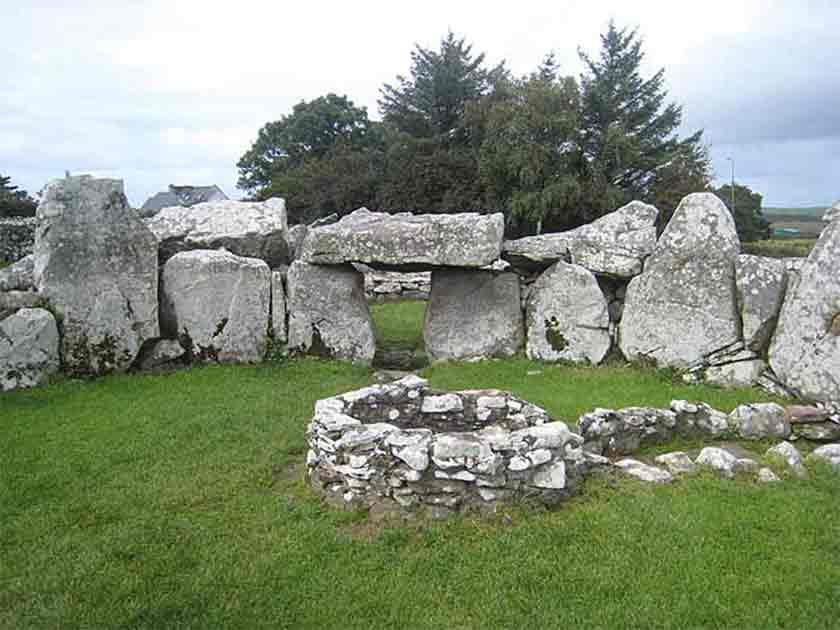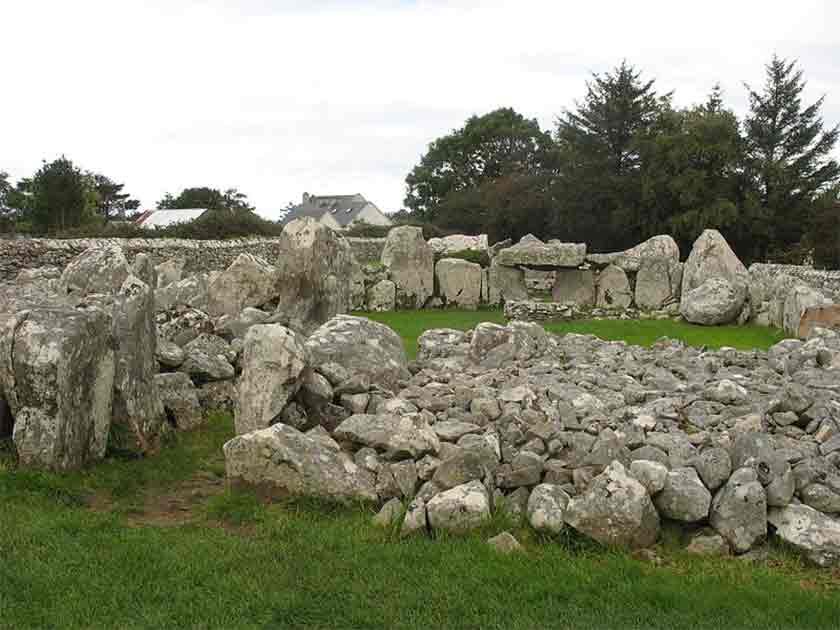Ireland is filled with ghosts. It’s ancient cultures, almost entirely mysterious to us, have left a windswept landscape littered with mysteries and strange places.
Among the strangest, and the oldest, can be found in County Donegal. Far out on the windswept Atlantic coast, the mysterious Creevykeel Court Tomb can be found, a neolithic marvel steeped in mystery and folklore.
With its weathered stones and haunting atmosphere, Creevykeel Court Tomb has captivated the imaginations of generations, drawing visitors from far and wide to ponder the secrets hidden within its ancient chambers.
Some say they have seen mysterious blue lights which come from nowhere and light the ancient stones with their eerie glow. Others have heard the ghosts of Creevykeel howling on the darkest of nights.
Who were these ancient people, who built this tomb? And who was the court of Creevykeel?
Artifacts, Giants and Spirits
Creevykeel Court Tomb, or Tuama Cúirte na Craobhaí Caoile to give it its proper Irish name, is one of the best-surviving examples of a court tomb left in Ireland. These megalithic tombs date back to around 4000–2500 BC and were examples of what is known as “chambered cairn” or “gallery” graves.

These monoliths, recognized by their uncovered courtyard, once numbered in the hundreds across Ireland and southwest Scotland. Some are older than the great pyramids of Giza.
While the site is known as Creevykeel today, amongst the locals it was once referred to as Caisleán Bhaoisgin, which roughly translates to “Castle of Enchantment”. Confusing things further, when archaeologists first cataloged the site during the 1900s, they gave it yet another name, “the Giants’ Graves,” owing to the many large stones found at the site.
Creevykeel Court Tomb holds all the hallmarks of a traditional court tomb. These structures tended to have a north-to-south orientation and were originally covered in cairns, all of which traits can be found at Creevykeel.
It’s believed their distinctive open courtyards, from which they take their name, were most likely used for ritual activities such as ancestral burials and pagan worship ceremonies. These would have been communal events attended by the whole tribe.
Creevykeel’s courtyard is oval, with its entrance set in the east and attached to a passage lined with standing stones. This courtyard is particularly impressive, measuring in at 15 meters (49 feet) long and 9 meters (29.5 feet) wide, making it one of the largest ever found in Ireland.
The western end of the court has a gallery that once served as the site’s burial chamber. The gallery’s entrance is guarded by two massive jamb stones (standing stones that form an entryway). These were topped by a lintel stone, which fell at some point but was put back in place during restoration work.
This arrangement would have meant that the enormous stones stood as a backdrop to whatever rites took place on the site. The visitors would have been gathered in the oval space on front, watching the ceremony performed in front of their honored dead. Neolithic Ireland, it seems, was not above a touch of theatre.

Beyond the massive doorway lies the gallery’s burial area, divided into two distinct chambers and split by more jamb stones. We know these were used for burials because, within them, four sets of cremated bones have been found. The gallery would also have been protected by a cairn, but that seems to have been destroyed long ago.
Discoveries, and Legends
Excavation works began at the tombs in July 1935, led by the fourth Harvard Archaeological Mission in conjunction with the Irish Free State Government. These digs not only uncovered how the site was built but also made some fascinating archaeological discoveries.
Items from both the Neolithic and early Christian periods were found, showing the site had been used again and again over millennia.
Of the items found, two of the most impressive are polished stone axes. The first was found buried between the jambs that divided the main chamber. The second, made of polished diorite, was found hidden between the jambs of the court entrance.
Other finds include a large knife made of flint (around 13cm (5 inches) long), a limestone arrowhead, many pot shards (including the remains of eight Neolithic pots), quartz crystals, and flint scrapers. The pottery shards, many of which are undecorated and dating back to the Neolithic and Early Bronze Age periods, suggest the oldest parts of the site were built during the Late Neolithic, roughly 2500 BC. However, it would appear that various parts of the site date to different periods.
In particular, a smelting pot or black furnace from the early Christian period was found to the east of the Neolithic chamber’s entrance. This area includes a circular structure with a hearth and flue-like structure, acting as a vent.
Archaeologists believe that the site was once abandoned and then later repurposed during the Early Christian period, going from a burial site to a foundry. Some historians surmise the site was chosen because locals suspected the forge metal workers would be able to summon the spiritual power of the site, enriching their work with magical powers.
- The Fomori: Ireland’s Mythical Raiders from the Sea
- Finn McCool, the Irish Legend: A Template for King Arthur?
For many generations, legends and folklore have surrounded the Creevykeel Court Tomb. Of them, the most famous is the strange appearance of eerie blue lights emanating from the site. Over the years, locals have reported seeing them, with various explanations given.
It was said that these lights were the spirits of the ancient dead, long ago buried there but still restless. Others claimed that the lights came from fairies or other supernatural entities that had set up shop there, attracted by ancient magic.
These were said to be the “little people,” or Tuatha De’ Dannan, the precursors to the more traditional Irish depiction of fairies and elves. After the bones of two infant children were found within the early Christian part of the site, locals began suggesting the lights were instead the ghosts of the children.

Unfortunately, a less mystical explanation exists for these stories. Creevykeel’s chambers were long used as a makeshift stillhouse, where a local kind of illegal homebrew called Poteen was brewed. This process likely explains the blue lights coming from the site: a different kind of spirit altogether.
Besides these ghostly goings-on, the site is also associated with sightings of a mystical white hare. Seeing this creature is said to be a supernatural omen, and locals have claimed it’s either a shape-shifting creature or some kind of guardian spirit.
The presence of massive monolithic stones, seemingly too heavy for ancient peoples to move, also gave rise to the idea that giants built the site. One story tells how Diarmuid, a famed giant of Irish legend, built the tomb to serve as his final resting place. In other tales, it is not Diarmuid who built the site but the hero of much Irish mythology, Fionn mac Cumhaill.
Whatever the truth, the Creevykeel Court Tomb stands as a timeless monument in County Donegal, Ireland, shrouded in mystery and steeped in folklore. Its ancient stones whisper tales of the past, captivating locals, and visitors alike with legends of blue lights, white hares, and the specters of giants and heroes.
While archaeology sheds light on its historical significance, the tomb’s true allure lies in the rich mixture of myth and legend that enshrouds it. Through the ages, Creevykeel Court Tomb has remained a reminder of the enduring fascination with Ireland’s ancient past, where fact and folklore intertwine to create a captivating narrative that continues to intrigue and inspire.
Top Image: Much of Creevykeel Court Tomb has been lost, but what remains has stood there for millennia. Source: Rob Hurson / CC BY-SA 4.0.
By Robbie Mitchell